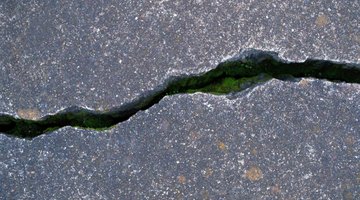How to Fix a Heaved-Up Concrete Slab
Frost heaves create hazardous and unsightly cracks in concrete slabs along a driveway, pathway or walkway. Left untreated, these cracks spread over the surface and make the slabs vulnerable to moisture damage. Concrete heaves when water underneath freezes, displacing the soil and damaging the slab.

You can address problems with the slab and prevent concrete heaves in the future.
Things You Will Need
- Circular saw
- Jackhammer
- Wheelbarrow
- Bolt cutters
- Steel rake
- Shovel
- Tape measure
- 2-by-6-inch lumber
- Hand tamper
- Crushed gravel
- Wire mesh
- Tin snips
- Wooden hand float
- Wood float
- Canvas
Tip
Wear thick gloves, ear muffs and protective eyeglasses when breaking concrete.
Remove Heaved-Up Concrete Slab
-
Cut the concrete slab into smaller sections with a circular saw and diamond blade. Ensure that the blade penetrates through the slab completely while cutting it. Set the saw aside.
-
Grasp the jackhammer handles firmly in your hands and position it over a cut line in the slab, at an angle. Turn it on so it pounds through the concrete. Push the jackhammer forward so it pries the broken concrete out of the soil, similar to a crow bar. Repeat the process along each cut line on the slab.
-
Collect the broken concrete pieces in a wheelbarrow.
Correct Subsoil
-
Rake the exposed substrate with a steel rake to loosen the crushed material, which is typically crushed gravel. Scoop out the loose gravel with a shovel and pack it in a mound nearby.
-
Determine how deep you should dig the subsoil. Ideally, you should pour the concrete slab 4 inches thick, along with 2 inches of gravel to help improve drainage. Measure the depth of the excavation and remove more soil until it falls 6 inches below the surrounding soil level.
-
Measure the length and width of the excavation and cut lengths of 2-by-6-inch lumber to size. Lay these boards against the walls of the excavation,.
-
Level the soil with a rake to remove debris, stones and weeds. Tamp the soil with a soil tamper to compact it, so it is firm and provides a stable base for the concrete slab.
-
Pour 2 inches of gravel over the compacted soil and tamp it with a tamper. Mist the gravel lightly to reduce friction from rubbing stones before tamping it. Continue to pour more gravel and tamp it until it forms a layer 2 inches thick. The compacted gravel should fall 4 inches below the surrounding soil.
-
Measure and cut a piece of wire mesh to size so it fits over the gravel. Cut the sheet with tin snips and lay it across the surface to help reinforce the concrete.
Pour Concrete
-
Prepare concrete according to label directions. Pour wet concrete into the frame until it reaches the top. Spread the poured concrete into corners with a hoe.
-
Smooth the surface of the concrete with a wooden hand float. Drape a wet canvas over the concrete and leave it to cure for one week.
-
Inspect the concrete to ensure it is cured after a week, or leave it for longer.
The Drip Cap
- Frost heaves create hazardous and unsightly cracks in concrete slabs along a driveway, pathway or walkway.
- Concrete heaves when water underneath freezes, displacing the soil and damaging the slab.
- Cut the concrete slab into smaller sections with a circular saw and diamond blade.
- Rake the exposed substrate with a steel rake to loosen the crushed material, which is typically crushed gravel.
- Pour 2 inches of gravel over the compacted soil and tamp it with a tamper.
- Prepare concrete according to label directions.
- Spread the poured concrete into corners with a hoe.
References
Writer Bio
Tanya Khan is a freelance author and consultant, having written numerous articles for various online and print sources. She has a Master of Business Administration in marketing but her passion lies in writing.
Photo Credits
- Thinkstock/Comstock/Getty Images
- Thinkstock/Comstock/Getty Images
More Articles



